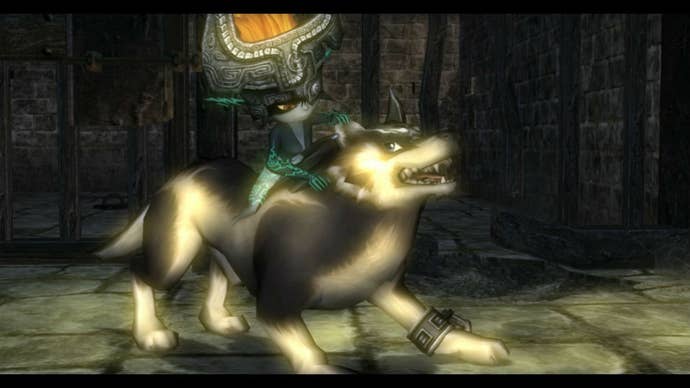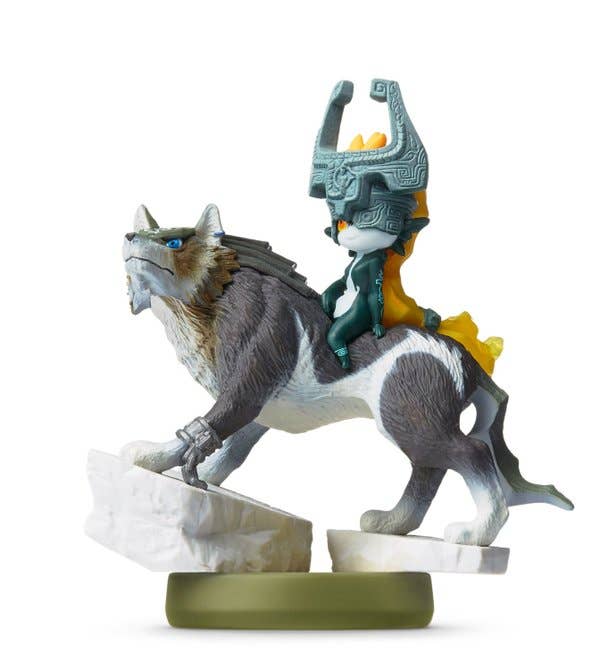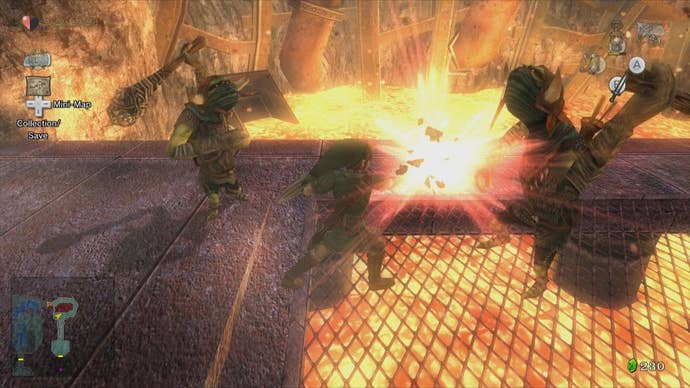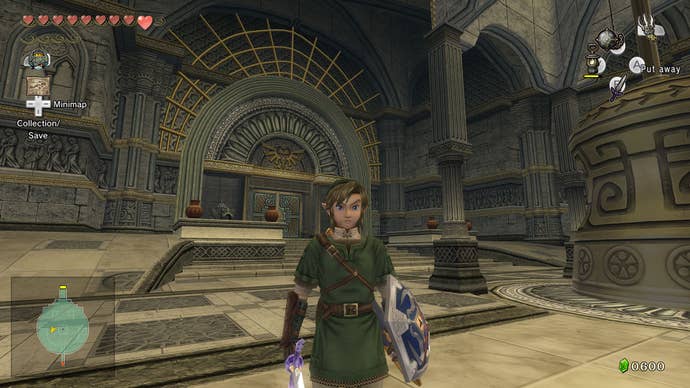The Legend of Zelda: Twilight Princess HD Wii U Review: The Long, Twilight Struggle
Twilight Princess is back after a decade, but its motion controls aren't. Does it hold up?
This article first appeared on USgamer, a partner publication of VG247. Some content, such as this article, has been migrated to VG247 for posterity after USgamer's closure - but it has not been edited or further vetted by the VG247 team.
Few games have needed an HD update more than The Legend of Zelda: Twilight Princess. The now decade-old entry has long been cursed with being shoehorned on to the Wii as a launch title, leaving most people to remember its gimmicky motion controls and not much else. It was due another look.
As one of Twilight Princess's biggest boosters over the years, I've been waiting for the day it would have a chance to be vindicated. And with that day now here, I can say that Twilight Princess is resoundingly... decent. It has its moments of brilliance, but it's weighed down by a glut of padding and overshadowed by the more successful Ocarina of Time. Its chief problem, ultimately, is pacing - an issue shared by Skyward Sword, its even more ponderous successor.

This is not a new complaint. Twilight Princess has taken plenty of criticism for its slow opening over the years; and having now played it again for the first time in years, I have to say that I agree. Twilight Princess moves sleepily through its opening hours as Link wrangles goats on the back of Epona, fishes, and rescues wayward villagers before finally kicking into gear with the introduction of the Twilight Realm - a shadowy world that has taken over Hyrule. In the Twilight Realm, Link is transformed into a wolf, his only assistance coming via the mischievous creature Midna, who offers hints on how to escape while riding on his back. Much of the first half of the game is built around recovering Hyrule from the Twilight Realm while unraveling both its true nature and that of its ruler. Midna, it should be mentioned, is a real delight. Twilight Princess is really her story, and that evil grin of hers contrasts nicely with Link's more straightforward heroism. Beyond that, having her around is a big improvement over Navi's constant cries of, "Hey! Listen!"

From a visual standpoint, the Twilight Realm is both a strength and a weakness in HD. Its necessary bleakness stands in stark contrast to Wind Waker's sunny skies and blue seas, which means it doesn't pop as much in high-definition as its more stylized predecessor. Granted, it's not as if Nintendo went all Gears of War with Twilight Princess. The Twilight Realm's shadowy monsters bring to mind Princess Mononoke, and Midna herself wouldn't be out of place in a Ghibli film. Not surprisingly, Twilight Princess has its clearest sense of identity when Link becomes a wolf.

On the other hand, some of Twilight Princess's weakest sections take place in the Twilight Realm. To open up Hyrule in the early going, Wolf Link has to uncover luminous insects scattered through each area, many of which are hidden in hard-to-reach locations. There are some decent traversal puzzles to be found here, and the atmosphere is undeniably spooky; but by the third round, I was ready to be done with the bug hunting. Thankfully, Twilight Princess eventually dispenses with this structure, which feels a lot like padding.
Once Link gets the Master Sword, Twilight Princess starts to cook a bit, with the result being some of the best dungeons in the series. The Snowpeak Ruins proves a delightful surprise in more ways than one, and the Arbiter's Grounds is similarly excellent, though its item is all but useless outside of the dungeon - a common criticism of the series. Interestingly, one of my favorite dungeons is the Goron Mines, which comes in the early part of the game. I had totally forgotten that you spend a good deal of your time traversing the walls and the ceiling in that dungeon, which made it a pleasant surprise.
Comparisons to Ocarina of Time are inevitable. Like its better-known predecessor, Twilight Princess is set in Hyrule, and familiar locations like Kakariko Village and Lake Hylia pop up early and often. Twilight Princess also traces Ocarina of Time's Forest Temple - Fire Temple - Water Temple path, giving it a little bit of a "been there, done that" feeling early on. Outside of the Twilight Realm, the main difference between the two is that Twilight Princess strives to be bigger and, for the lack of a better phrase, more epic. The combat in Twilight Princess is more elaborate, featuring up to seven unlockable hidden abilities, and it leans more heavily on big cinematic setpieces. I get a bit of a Lord of the Rings vibe from some of its horseback chase; and for the most part, it works. It feels cool, even if the impact of such scenes has been reduced by Twilight Princess's older graphics.

Taken together, its apparent that Twilight Princess was designed in response to the criticism that Wind Waker was too short. Just getting into a dungeon frequently requires you to undertake multiple subquests, with plenty of exploration in between. At its best, it feels like the epic it set out to be, with moments like the battle with King Bulbin on the bridge being some of the best in the series. At its worst, it feels like Nintendo larded in dungeons like the underwhelming Temple of Time to keep people from complaining about the length. It's an admittedly difficult balance to strike, but it ends up doing real harm to Twilight Princess's pacing.
Because of this, I have mixed feelings about Twilight Princess. It's made me appreciate how tightly designed and balanced Ocarina of Time really is; it's made me appreciate Wind Waker's clear sense of identity, and it's made me appreciate Majora's Mask's willingness to play with the franchise's structure. Twilight Princess has scale going for it, as well as some really excellent dungeons, but it feels disjointed and too reliant on the foundation set by Ocarina of Time. In the end, I'm forced to conclude that it's one of the weaker Zelda games, which is not the feeling I had going in. I guess it's kind of the anti-Wind Waker HD in that regard.

Having said that, I'm still glad this HD version exists. It's not a complete overhaul like Wind Waker HD, but Nintendo has done their customarily excellent job with this remaster, with the characters in particular seeing clear improvement. The environments are a little more hit and miss - lots of drab wall and ground textures - but areas like the Ordon Woods still look lush and beautiful. In general, Twilight Princess still looks good, and its helped by the addition of new high-definition textures.
The new content is a bit more sparse, being mostly limited to Amiibo exclusives. The most notable addition comes via Wolf Link, who opens up the Cave of Shadows - a wave-based gauntlet similar to the Cave of Ordeals. From a gameplay perspective, however, the Ganon Amiibo may actually be more interesting, as it actually doubles the damage Link takes - perfect for challenge streams on Twitch. Beyond that, most of the changes are limited to tweaks like requiring you to only collect 12 Tears of Light instead of the original 16 (thank god), and Link's wallet being bigger.
More important than the visuals or the extras, though, is availability. With the Gamecube version of Twilight Princess being comparatively rare, it's long been difficult to find a version of the game that isn't saddled by motion controls and a right-handed Link. It's the tiniest bit disappointing that the Wii Remote isn't even an option in this version - the only motion controls involve using the Wii U Gamepad to aim your bow and arrow - but at the end of the day, I'm not all that sad that they're gone. In my mind, Twilight Princess will always be the Gamecube's swan song rather than the Wii's debut.
A decade on from its original release, Twilight Princess has undeniably lost some of its original appeal, which was defined in part by its being a bigger, prettier Ocarina of Time. Nevertheless, its elaborate dungeons have held up just fine over the years, and it's an undeniable pleasure to explore. This high-definition re-release may not do much for its reputation in the long run, but it's worth revisiting nonetheless.
InterfaceThe controls are fine, but there have been points where I simply can't get the camera to where I want it to go. It's not a huge issue, but it's popped up here and there throughout the game.
SoundZelda's customarily excellent soundtrack nicely balances the epic and the atmospheric. The characters don't have any voiced lines, but I can still hear Midna in my head.
VisualsFlat overworld textures betray Twilight Princess's origins, but it still looks very good in high-definition. Just being able to play it in high-definition is a big improvement.
ConclusionIt's great to finally have a high-definition port of Twilight Princess - it needed one more than most. Its strong dungeon design holds up well enough, but its meandering pace is unlikely to win over its detractors. Still, if you missed it the first time, give it a look. If nothing else, Midna is still a delight.









